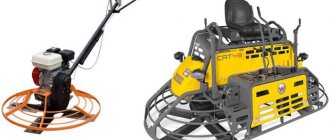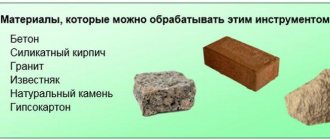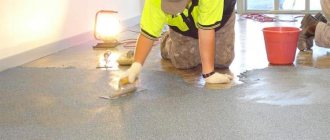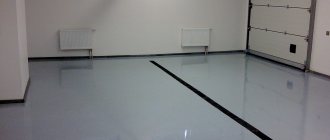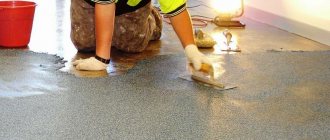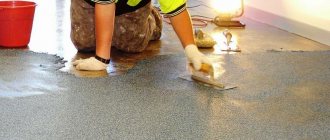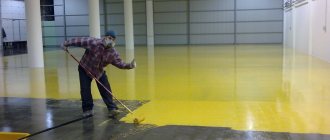Concrete trowel is equipment used to process concrete surfaces to ensure high quality coating. Using devices of this type, you can give concrete surfaces a smooth and beautiful appearance, without significant costs for this procedure. Modern power trowels can do a lot. The trowel performs work quickly, the treated surfaces are more wear-resistant and have incomparable strength. It is impossible to achieve such impressive results manually - the work speed is much lower, the technology is completely different. Popularly, grouting machines are called “construction helicopters” due to their external similarity with the type of equipment of the same name, however, the principle of operation is different. A concrete trowel does not use blades to force air. The trowel discs and blades come into direct contact with the concrete, troweling it.
Types of trowels
The main parts of the devices under consideration are the troweling blades and the disk. Grouting blades are made of stainless steel, usually in the shape of a rectangle with an upward-curved outer edge. The number of blades may vary depending on the specific model. Grouting discs are fixed on the blades and allow you to level the most uneven areas.
The concrete trowel can be equipped with either a gasoline or electric motor.
Gasoline trowel for concrete
A gasoline concrete trowel can work anywhere, without external power sources. The gasoline-powered concrete trowel uses the well-known internal combustion engine, with an average power of 6 horsepower for manual models, and up to 25 horsepower for models equipped with an operator seat.
A gasoline power trowel is recommended for use in open areas, since during operation it produces exhaust gases that poison the surrounding area. Another solution to the problem is to remove gases outside the room using a special device.
Electric trowel for concrete
An electric concrete trowel can only be used in places where there is an electrical network, since it is connected to a fixed network. Don’t forget - there are gasoline generators on the market that can provide power to an electric trowel, expanding its consumer characteristics and capabilities. Meanwhile, a generator costs a significant amount of money, which increases the overall cost of the necessary equipment.
The classification of grouting machines is also carried out according to the characteristics of use. There are small brands - a wall trowel, which is used for processing hard-to-reach surfaces (places with a large number of corners, doorways). The second type of trowel is the single-rotor trowel. The single-rotor trowel is the most common. A medium-sized trowel, suitable for most tasks. The largest concrete trowel is the two-rotor trowel. This type of trowel is used to process surfaces of considerable size; it is clumsy, but is capable of processing huge areas.
Types and features of units
The number of blades of the trowel determines its type. The units can be: single-rotor and double-rotor.
Their photos and features can be found in the table:
| Unit type | Peculiarities |
| Such machines for finishing concrete floors are used on construction sites, with an area limited to 500 m². Models have electric or gasoline drives. In this case, the device is equipped with one disk, the diameter of which can reach 1.2 meters. The force and speed of rotation are easily adjusted. You control the unit yourself using an extended handle with buttons and levers. Single-rotor “helicopters” are:
|
| These are professional self-propelled devices, large in size and with high performance, used in free, unobstructed areas, the size of which is more than 700 m². Such models are equipped with two trowel discs with a diameter of 0.6 to 1.2 meters. These machines are powered by electricity and liquid fuel. Some models equipped with hydraulic drive can be controlled using joysticks. In this case, the operator, sitting in a comfortable chair between the rotors, can drive the machine and control its operating modes. Such units are manufactured with a high or low landing. |
Characteristics of trowels
A power trowel has different characteristics, and their types affect their final cost and intended use. The following characteristics are distinguished:
- Operating procedure (either by walk-behind tractor type or with an operator’s seat). A small trowel is equipped with a folding or non-folding handle, and large units are necessarily equipped with a seat;
- Fuel type (gasoline, electricity). The advantages and disadvantages of electric and gasoline engines are described above;
- The power of the motor that the trowel has. The power of gasoline engines ranges from five horsepower on manual models, and up to 25 horsepower on driven models. The power trowel has electric motors ranging from 0.5 to 4 Kilowatt.
- Fuel tank volume (for gasoline models). The trowel has a tank capacity from 1 to 10 liters.
- Engine manufacturer. Most often, trowels on the market are from manufacturers in China and the USA.
In addition to the specified characteristics, trowels differ from each other in the following parameters:
- Blade diameter;
- Diameter of the protective ring;
- Number of blades;
- Blade rotation speed;
- The presence or absence of transport wheels;
- Weight.
To choose the right device, you need to select the characteristics based on your goals.
Application area
Concrete trowels are widely used in cases where the volume of work is significant. Consumers of the trowel are builders, construction teams, organizations engaged in the construction of apartment buildings and cottages, repair organizations, that is, all those legal entities that are associated with the implementation of construction or repair work.
For domestic needs, the use of this type of equipment is not always justified. This is due to the fact that grouting machines are quite expensive and are designed for repeated use to achieve payback. A concrete trowel simply cannot be cheap, since it is quite complex equipment. For domestic needs, a power trowel is purchased in rare cases. Most often, consumers - individuals, rent a concrete trowel. In this case, the rent is only slightly affordable, and the task is completed without unnecessary material costs.
A concrete trowel can be used everywhere, especially if there is a need to trowel concrete slabs. The trowel can be used for constructing floors, compacting surfaces after pouring concrete, and preparing surfaces for further coating.
Work process
A concrete trowel is professional equipment, however, the work process is not overly complicated and can be easily mastered by anyone, regardless of qualifications and the presence or absence of special education.
Initially, concrete is poured and compacted. Once the concrete screed has gained sufficient strength (the process takes up to 15 hours), work can begin to level the surface. Determining that the mixture has frozen is quite simple - if an adult stands on the poured surface and the foot sinks to a depth of 3 millimeters, then work can begin. If the concrete has not hardened enough, you must wait until the concrete surface dries out.
The processing process should be divided into stages - roughing and finishing. The draft stage is the initial one. At this stage, a special disk is used to roughly smooth the surface. At this stage, the machine smoothes out unevenness and differences, making the surface suitable for further processing. It is recommended to do at least two approaches, taking into account the fact that the concrete hardens faster in the corners of the area. The trowel will become the main tool at this stage.
After all the most uneven places have been smoothed out, grouting with blades is applied. In this way, the surface is compacted as much as possible, and the top layer of concrete is not destroyed. You should pay attention to the angle of installation of the blades. For the first approach, it is recommended to set the angle to 5-10 millimeters, increasing it to 20 millimeters for the second approach. As a result of the work, the surface becomes perfectly flat. No master can achieve such an impressive result manually.
From the outside, a power trowel works in the same way as a snow blower or a lawn mower. The operator moves the device over the surface of the mixture, smoothing it. There are no significant difficulties in the work. There are power trowels with a seat for the operator. In this design, the operator controls the device by sitting on it and switching the corresponding control levers. A machine of this type requires some effort during transportation and operating skills, however, subsequently, you can get a large area treated with trowels.
What types of equipment are there for concrete grouting?
For these purposes, builders use various types of trowels or, in the professional slang of builders, a construction helicopter. Smoothing equipment allows you to smooth out protrusions, eliminate unevenness, sagging, and cracks formed as a result of pouring the concrete base. And to do this in a short time and over large areas.
Processing a concrete surface using construction helicopters also allows you to remove excess moisture, compact and prepare the surface for subsequent processing. In addition, they are used for grouting dry mixtures when applying a reinforcing layer.
Equipment prices
Grouting a concrete surface using the machines in question requires either purchasing or renting these devices. The rental price of such a machine may vary, since each owner of the equipment installs it independently. The selling price of such trowels depends on their characteristics and manufacturer.
In Moscow, the price for devices of this type starts from 23-27 thousand rubles. These models are not of high quality, however, they are much cheaper than devices from famous manufacturers. The sale of Chinese devices is proceeding at a very brisk pace, however, if there is a need to purchase a truly high-quality machine, you need to look towards other manufacturers. In general, the price can vary from 23 thousand rubles, and reach 250,000 rubles, depending on the specific car. The market also presents goods of Russian and Belarusian origin. Considering the price of consumables, we can conclude that they are insignificant. An example is a grouting disc that costs about 3,000 rubles.
So, a concrete trowel can be a great help. It does not matter for what purpose it is purchased - for renovation in a small apartment or for large-scale construction of a shopping center. By choosing the right characteristics, you can choose a reasonable option, which, with proper care and maintenance, will delight you for many years. You need to understand that a trowel is professional equipment, without which it is impossible to trowel concrete truly evenly.
Machine for smoothing or troweling concrete floors
This machine is used for high-quality finishing of freshly poured concrete surfaces, mechanical grouting of uneven surfaces and making it ideally smooth. After this machine has passed through this, the surface can easily be further finished. In addition, it gains greater strength and wear resistance.
The smoothing machine is a motor located vertically at the bottom, with mounted blades or disks. In more detail, a machine can have from one to four working bodies. For example, if a machine with four has: a screed (or shaft), a trowel belt, a vibrating compaction bar and a screed. The machine compacts and levels through vibration. That’s why the machine is called a “helicopter” - during operation it rattles from rotation and translational movements up and down. A thick metal mesh type fencing reliably protects the worker. The machine has a handle with control levers that extends from bottom to top.
Smoothing machines are used in two stages. The first is when the concrete is dry enough so that it does not press more than 2-3 mm from the shoe footprint. The machine has blades (disks) located at an angle of 0-30 degrees. When they rotate, the machine seems to press in the protruding irregularities of the concrete, pressing them with rotating blades (or disks). After 12-15 hours the car goes through the finish line again. At this stage, the concrete should completely “stand up”. Visually we determine: it has darkened and hardened, it does not press through at all.
Smoothing machines create a surface with a service life increased several times. The machine is easy to maintain. The machine is easy to maintain. Since the smoothing machine is equipped with a rotation speed control lever. The machine can be easily transported in a car.
However, the big disadvantage is the high cost of the smoothing machine. Foreign models are of high quality, but such a car costs from $5,000. Domestic engines cost 2-3 times less.
Why is concrete grinding necessary?
The main task performed by concrete grinding is to open pores in concrete . The surface layer of both “old” and new concrete differs from the underlying ones in mechanical properties. It has a completely different capillary-porous structure, which prevents the effective penetration of soils and coatings into the concrete body. The main goal when grinding a freshly laid concrete floor is to remove cement laitance, and when grinding an old one, it is to remove the weakened carbonized surface layer.
The penetration of soil into the pores of concrete is a very important factor for the reliable and long-term operation of polymer-coated floors. If the concrete floor surface is not sanded first, the coating will begin to peel off over time under the influence of mechanical, chemical or vibration loads.
Concrete surfaces are also ground for ideal evenness for further finishing.
Grinding is a rather labor-intensive and complex process, so builders use special equipment for grinding concrete floors. On the modern market, this equipment is presented in different types and in different configurations. But all grinding machines are designed according to an identical scheme: an abrasive element is attached to rotating disks . Thanks to different machine powers and tool grains, matte, semi-matte, glossy or mirror-glossy surfaces are obtained.
Types of smoothing machines
Grouting machines vary in engine type. There are gasoline and electric cars. A gasoline smoothing machine will be more powerful, but for safety reasons such machines cannot be used in enclosed spaces. An electric car with a wire - you need to monitor its movement. But such a car is many times cheaper.
In terms of power and dimensions. A single-rotor machine can be from 60 cm in diameter (up to 120 cm), which makes such a machine more cost-effective for finishing floors in residential and domestic premises. Double-rotor machine - for large areas. This machine has a comfortable seat on top. The machine is controlled by two levers. Such a machine is much more powerful and more expensive, and is used mainly by construction organizations.
It must be said that smoothing machines with one rotating rotor are easily operated by the worker himself by the handle, like a gas mower. And with two rotors - a self-propelled machine, with a person on top.
Where is floor hardening used?
You can treat floors with a trowel in any room. This will increase its strength, water resistance, and reduce dust formation. You can use concrete of a lower grade - this reduces its cost. When machine processing the screed, preparation for laying the floor covering can be considered complete - no additional leveling is required.
It is not necessary to use all the technology for strengthening floors in apartments. The concrete is still covered by the floor covering and is not subject to mechanical stress.
Another thing is warehouses, gyms, swimming pools, parking lots and production workshops. People not only drive, walk, and drag loads on such floors, but also spill various liquids – water, fuels and lubricants and other “chemicals.” Therefore, it is no longer possible to do without additional strengthening substances.
What to look for when choosing
Diameter. For domestic and residential buildings, especially with columns, a maneuverable machine with a small diameter is needed. For example, 60 cm. But a machine with a larger diameter has greater productivity. For quick finishing of large areas, a machine with a diameter of 90 cm and above is suitable. A machine with a diameter of 90 cm is considered universal.
Power, and therefore the quality of grout, depends on the engine speed range. A machine with a wide range is more versatile. If you need a machine for rough and final mashing, the speed should reach at least 200 rpm. per minute Well, and the type of engine, brand. A car with a higher quality and more powerful engine will cost more.
Lastly. Before making a decision, we recommend watching a video on the Internet or on a construction site to see how the smoothing machine works. It doesn’t take much effort, the main thing is to manage and lead in the right direction. Although the machine is easy to operate, the staff still needs to undergo a little training. Since the machine is very noisy, do not forget to stock up on earplugs or headphones. It will be a great relief for you to have an amazing smoothing machine invented by wise people.



